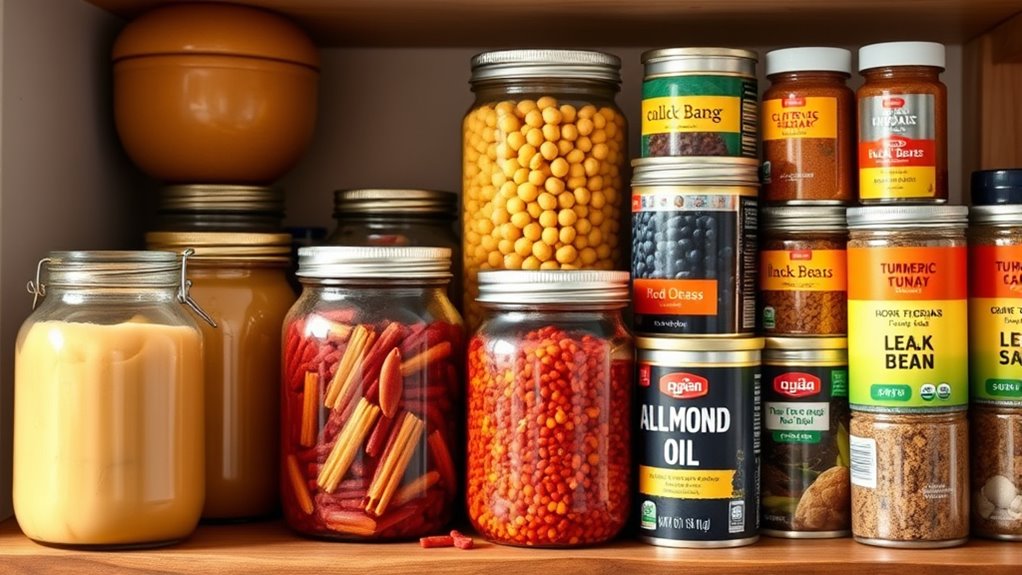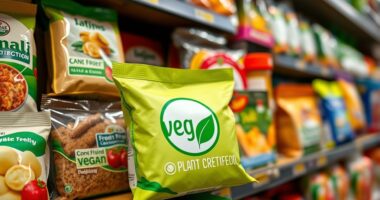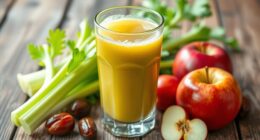To build a robust vegan pantry, stock staples like grains (rice, quinoa, oats), legumes (lentils, chickpeas), nutritional yeast, and healthy oils. Keep a variety of dried herbs, spices, soy sauce or tamari, and vinegar to enhance flavors. If you’re missing something, substitutes like coconut aminos for soy sauce or tahini for nut butters can work well. Keep these essentials accessible and learn how flavor layering can elevate your dishes—more tips are just ahead.
Key Takeaways
- Keep a variety of dried herbs, spices, and flavor enhancers like nutritional yeast and soy sauce for versatile seasoning.
- Stock pre-cooked grains and legumes to streamline meal prep and ensure quick assembly of dishes.
- Use substitutes such as coconut aminos for soy sauce or nutritional yeast for cheese flavor in recipes.
- Toast spices and seeds to boost aroma and deepen flavor profiles in your cooking.
- Incorporate acidic elements like lemon juice or vinegar to brighten flavors and add complexity.

Having a well-stocked vegan pantry makes meal planning easier and guarantees you always have ingredients on hand for nutritious, plant-based dishes. When you keep essential staples within reach, you can whip up meals quickly and confidently, knowing you have the right ingredients. To optimize your pantry, it’s helpful to incorporate meal prep tips that streamline cooking and make flavor enhancement techniques second nature. For example, prepping grains and legumes in advance saves time during busy weekdays, allowing you to assemble meals faster. Cook a batch of rice, quinoa, or lentils early in the week, then store them in airtight containers. This not only reduces cooking time but also ensures you always have a base for salads, bowls, or stir-fries.
Flavor enhancement techniques are equally important in elevating simple ingredients into delicious dishes. Stocking staple seasonings like nutritional yeast, soy sauce or tamari, and a variety of dried herbs and spices allows you to experiment and find flavor combinations that suit your palate. For instance, adding a splash of tamari or soy sauce can deepen the savory profile of your dishes, while smoked paprika or cumin can introduce warm, smoky notes. Using ingredients like garlic powder, onion powder, and dried herbs can transform basic grains and legumes into flavorful meals without extra effort. Remember, a little goes a long way, so start with small amounts and adjust to taste.
Having a versatile selection of pantry staples also opens up opportunities for flavor layering—an essential flavor enhancement technique. Toasting spices before adding them to dishes releases their aromatic oils, intensifying their flavor. Incorporate toasted cumin seeds in your rice or sprinkle paprika over roasted vegetables for a burst of smoky aroma. When planning your meals, consider how combining different seasonings can create depth and complexity. Mix fresh herbs with dried ones or add a squeeze of lemon or vinegar at the end of cooking to brighten flavors.
Frequently Asked Questions
How Long Do Vegan Pantry Staples Typically Last?
Vegan pantry staples typically last from several months to years, depending on the item and storage conditions. For maximum storage longevity, keep dried goods in airtight containers in a cool, dark place. Check expiration tips on labels regularly to guarantee freshness. Staples like canned beans or lentils can last 1-2 years, while dried herbs may last 1-3 years. Proper storage helps prevent spoilage and extends their shelf life.
Are There Any Vegan Pantry Staples That Need Refrigeration?
You might find yourself in a pickle if you don’t store certain vegan staples properly. Some items, like tofu, nut butters, and certain plant-based milks, need refrigeration due to perishability concerns and refrigeration necessity. Always check labels, as shelf stability varies. Keep these staples in a cool, dry place when possible, but don’t hesitate to refrigerate to extend their shelf life and keep them fresh for longer.
Can I Substitute Fresh Ingredients for Dried Ones?
Yes, you can substitute fresh ingredients for dried ones, but keep in mind the flavor and texture differences. Fresh herbs or vegetables often have a more vibrant taste, while dried versions are more concentrated. Use substitution tips like reducing the amount of dried ingredients by about one-third to one-half when replacing with fresh, and adjust cooking times accordingly. This way, your dishes stay flavorful and balanced.
What Are Some Budget-Friendly Vegan Pantry Staples?
You can save money by stocking up on budget vegan staples like dried beans, rice, oats, and canned tomatoes. These ingredients are versatile for vegan meal prep and make budget vegan snacks easy to create. Keep a variety of spices and pantry essentials on hand to enhance flavors. With these staples, you’ll stay within your budget while enjoying nutritious, plant-based meals and snacks anytime you want.
Are There Gluten-Free Vegan Pantry Staples Available?
Yes, there are plenty of gluten-free vegan pantry staples for you to explore. You can use gluten-free flours like almond, coconut, or rice flour for baking. For snacks, consider gluten-free vegan options like rice cakes, popcorn, or fruit and nut mixes. These staples help you whip up delicious, healthy meals and snacks without gluten or animal products, making your vegan lifestyle more accessible and enjoyable.
Conclusion
Think of your pantry as a garden bursting with potential—each staple a seed waiting to grow into delicious, nourishing meals. With these vegan essentials and clever substitutes, you hold the keys to a world of flavorful creations. Embrace these ingredients as your trusted tools, transforming simple dishes into vibrant, satisfying experiences. Your kitchen isn’t just a space—it’s a canvas, and your pantry is the palette of endless, colorful possibilities. Let your culinary journey flourish!










